JOLED Demos 21.6-Inch OLED Monitor for Gamers
by Anton Shilov on December 28, 2018 12:20 PM EST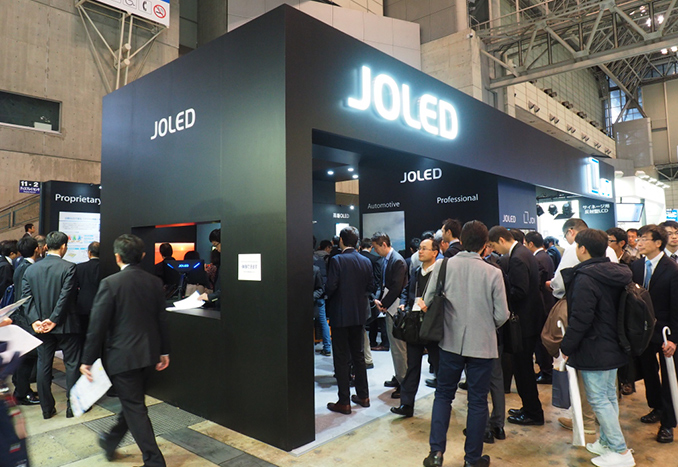
JOLED, a joint venture between Sony and Panasonic, has demonstrated multiple PC-oriented printed OLED-based monitors at Finetech Japan trade show. Among other things, the company exhibited OLED displays for gamers, home applications, and professionals. Some of the products are already on the market, or are about to be released, and others are prototypes.
One of the advantages that OLED has over conventional LCD technology is a very fast response time, which makes the tech particularly appealing for gamers. Meanwhile, due to cost and longevity reasons, hardly any company has addressed this audience with an OLED solution. At the show JOLED demonstrated a prototype of its 21.6-inch OLED display that was co-developed with Burning Core, a Japanese gamers team that JOLED sponsors. The monitor features a 1920×1080 resolution and was test driven at Finetech Japan.
In addition to a 21.6-inch Full-HD OLED panel, JOLED also has a high-contrast 21.6-inch Ultra-HD OLED panel in its arsenal. The company has been shipping a medical 21.6-inch 4K OLED display under its own brand (presumably only in Japan) since late 2017. Also, a similar (or the same) 21.6-inch Ultra-HD OLED panel is used by ASUS for its ProArt PQ22UC monitor that is yet to hit the market.
Besides 21.6-inch OLED panels for consumer and professional applications, JOLED has developed a 27-inch 4K OLED panel too. The prototype the company demonstrated at the exhibition was a wall-hanging monitor aimed at smart home applications (smart speakers, IoT, etc.). The positioning of the device is a bit odd because a 27-inch OLED would have been a good solution for PCs, but for some reasons the company does not want to address this market with this panel just yet.
Also aimed at consumers is JOLED’s 55-inch OLED Ultra-HD panel for UHDTVs. This device was demonstrated as a proof of concept to show that the company’s printed OLED technology is suitable for large-sized applications such as TV sets.
Amongst its consumer/professional-oriented OLED devices, JOLED showcased prototype of a rather unique 21.6-inch column-style 4K monitor featuring plastic substrate. The similar substrate is also used for a 21.6-inch curved 4K display designed for digital signage applications in metro/trains and other similar places.
Related Reading:
- ASUS Unveils ProArt PQ22UC OLED Monitor: 4K, 99% DCI-P3, 0.1 ms Response Time
- New 8K OLED Displays for Tablets and Laptops: 8.3 and 13.3 Inches
- Dell’s Ultrasharp 30-inch 4K OLED Now On Sale: UP3017Q for $3500
- The Lenovo ThinkPad X1 Yoga Review: OLED and LCD Tested
Source: JOLED, OLED-Info (via TechPowerUp)


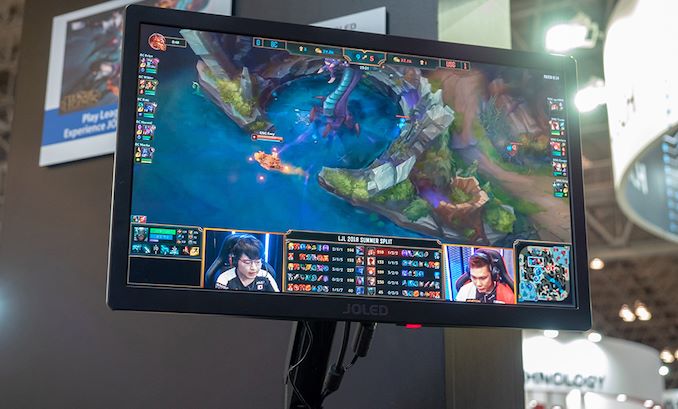
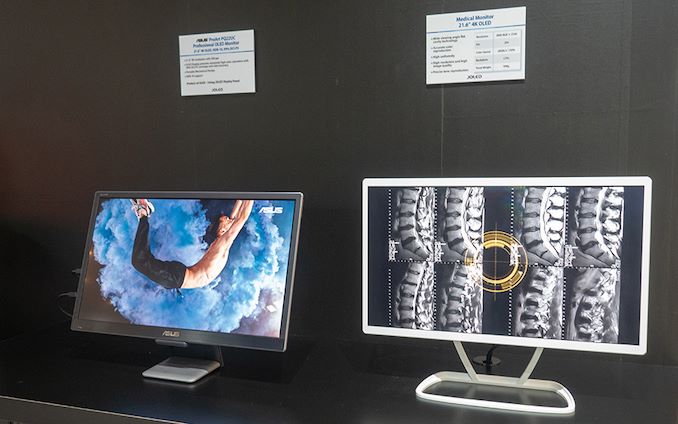
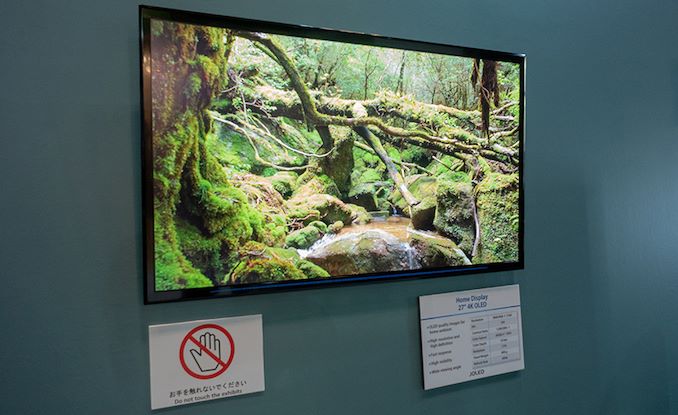
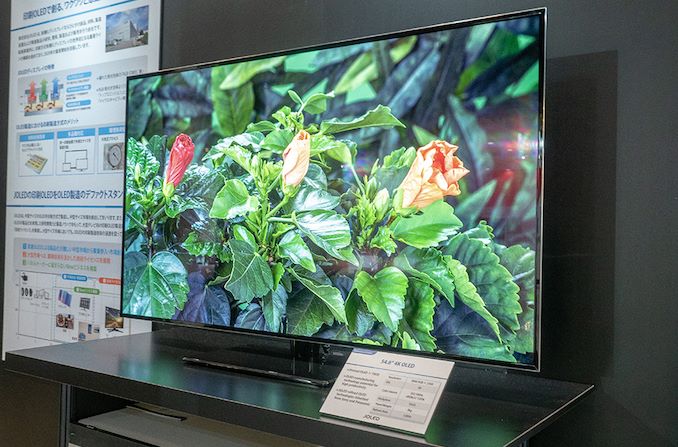
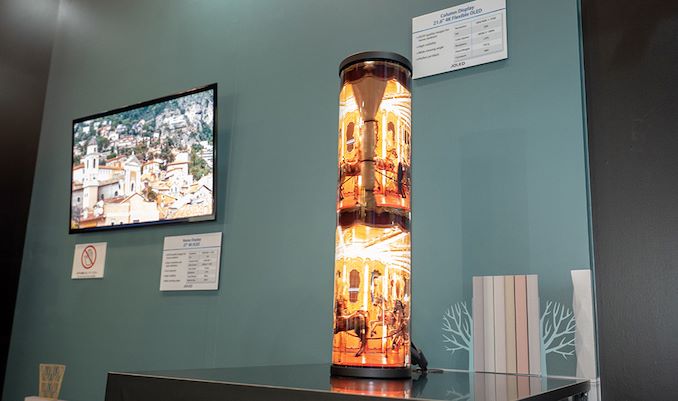









32 Comments
View All Comments
Beaver M. - Saturday, January 5, 2019 - link
Depends on if you needed it or not and if hardware was even capable to use it properly.Let me guess, youre not working in public relations.
fazalmajid - Saturday, December 29, 2018 - link
55" 4K OLED TVs like the LG C7 are within striking range of $1000, I can't understand why they don't make 31" computer monitors from 1/4 of a 65" HDTV panel.sing_electric - Wednesday, January 2, 2019 - link
There's a few reasons - there's forum posts around the Internet about people that have tried to use a OLED TV as a computer monitor, and it hasn't worked out that well: Even though the refresh rate is high, input lag is significant (~21ms for the LG C7), and the TVs experience burn when used for gaming/PC tasks. Plus, I'm willing to bet that color reproduction isn't great or that accurate - maybe you couldn't notice for gaming, but maybe you would.Some of those issues could be addressed by LG (or others) with a customized controller for monitors, but some can't.
Also keep in mind that for an LCD panel, the cost of the actual LCD panel itself is just a fraction of total BoM costs - so you can't just take 1/4 the cost of a TV as a starting point.
r3loaded - Saturday, December 29, 2018 - link
* OLED* 4K
* HDR
* 120Hz
* Adaptive Sync
* 24-32 inches
Make it so and I'll throw money at it.
Beaver M. - Monday, December 31, 2018 - link
4K useless still, because of too slow hardware.Make it 1440p and 240 Hz (shouldnt be a problem with OLED).
Oh and add G-Sync.
EnzoFX - Wednesday, January 2, 2019 - link
*Freesyncseascape195 - Saturday, December 29, 2018 - link
OLED tech is not gamer friendly due to its burn-in problem. Games are way to prone to images on screen in static locations and gamers trend on playing for many many hours (per day), often same game(s), so the static image isn't even changing frequently due to game switching. So, until OLED solves the burn-in problem.. this tech is DOA.notashill - Monday, December 31, 2018 - link
The high end gaming hardware market does not seem to mind buying the latest and greatest on a yearly basis anyway.It will definitely be a niche product until both the price and longevity improve a lot, but I expect there's at least enough of a market for them to be worth selling.
lewisl9029 - Wednesday, January 2, 2019 - link
Was going to post just this. I bought an LG OLED TV to use as a computer monitor a bit over a year ago, and burn-in marks from things like the windows taskbar, desktop background picture, tiling window borders, HUDs from games, etc, have become a constant distraction. I still keep it because the colors and contrast ratio are hard to let go of for watching movies in a dark room once you get used to using an OLED and start taking it for granted. But the next time I get an OLED it'll be exclusively for watching movies and nothing else.zodiacfml - Sunday, December 30, 2018 - link
I don't get it. How much were LG's OLED 1080p TVs back when they still exist?One can simply take those and tweak, brand them as monitors.
LG doesn't seem to have 4k OLED less than 55 inches, it could be too large for some as a monitor. Still, you get OLED monitor without fuss and excess cost.